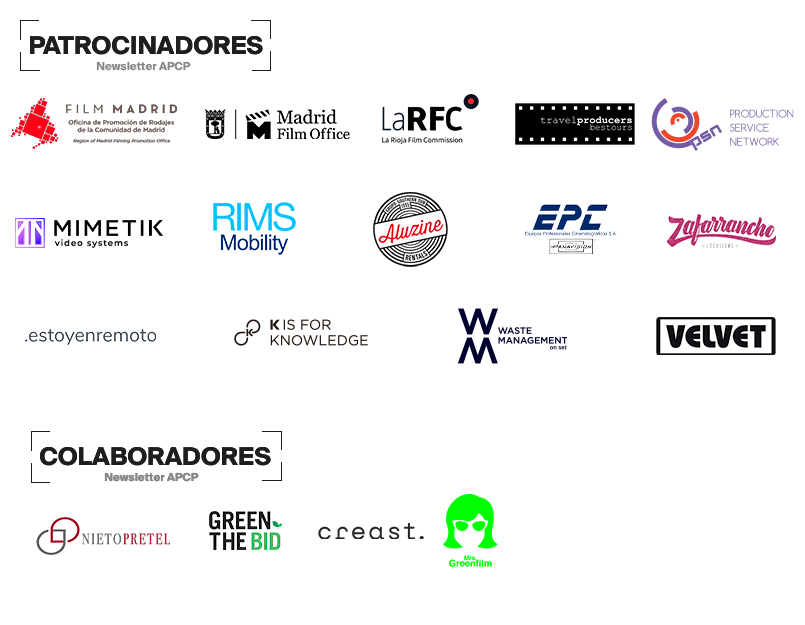
Earth Day has been celebrated every 22 April for more than 50 years, with the aim of raising awareness of the problems caused by overpopulation, pollution, biodiversity conservation and other environmental concerns.
To do our bit, our sponsors and partners, who are working towards more sustainable filming, wanted to remind us what we can do to take care of our planet within our industry.
In commemoration of Earth Day, K is for Knowledge wants to continue to encourage the Audiovisual Industry in its work towards a more sustainable industry. The power that the industry itself has with its communicative work, its capacity for engagement, its ability to be provocative, among many other capacities, the audiovisual industry must help to understand the importance of committing ourselves to real and global needs in the planet’s fight against the proven and suffered climate crisis caused by human beings and their activities.
The individual is the main agent and target so that through his or her actions, the ways in which we have been organising our projects can be changed. Advertising and film production companies, event and festival organisers must incorporate programmes with responsible policies that help to introduce new criteria to reduce the negative impacts and the continuous generation of emissions that significantly damage the planet, but also individuals, human beings who have already seen the consequences of a lack of responsibility in our lives and health conditions, and where there is an increasing concern about being responsible for this kind of ungenerous legacy that we are going to hand over to our future generations.
Since 2022, at K is for Knowledge, we have been working with some people and companies that have already taken their first steps and through the calculation of the Carbon Footprint of their projects, we have been able to correct and propose new alternatives to reduce the negative impacts on the environment and reduce the volume of emissions. At Waste Management On Set, we have already managed to prevent tonnes of waste from ending up in the wrong place, giving them the opportunity to be revalued and supporting the circular economy, that is, helping Mother Earth and reducing the high demands we make on her every day.
But there are still very few of us who are committed, from K is for Knowledge, we encourage you to be part of this movement where we have shown that we can continue to produce in a responsible way, without affecting the profitability of the projects and without harming the planet and society itself, if not quite the opposite, being an industry where the benefits of being sustainable and responsible with the environment are an advantage for everyone.
Creast offers its users access to all its services and digital tools to measure, reduce and offset their emissions. And today they wanted to share with all of us some tips for your work routine that the planet will thank you for.
Teach your colleagues
– Share your knowledge of sustainability with your colleagues, outreach is one of the weapons we have to defend the planet, help us!
– Introduce in all your digital communications a sentence that reminds you of your commitment to the environment, such as adding a reminder not to print in all your emails. Continuous awareness is the only way to make the guidelines for improving sustainability in our work last.
Energy
– Turn off all lights in rooms and common areas that are not in use and switch off and unplug all devices and appliances when not in use. Remind your colleagues to do the same. By complying with this rule, you will reduce energy consumption by more than 10%, reducing your carbon footprint and costs.
– Activate screen lock on all devices (computers, mobiles, etc.).
– Use electronic devices with energy-efficient certifications, you will greatly reduce your energy consumption.
Transport
– Use public transport, most of the emissions in our work activities derive from transport. Public transport has a much lower environmental impact than travelling by car or motorbike.
– When planning journeys, always prioritise rail over air travel, as it has a lower environmental impact per km and per passenger. It is estimated that, on average, the plane emits about 285 kg of CO2 per passenger per kilometre, while the train emits about 14 kg per passenger per kilometre.
– When flying, choose airlines that are committed to sustainability.
– When using taxis or VTC, ask for hybrid and electric vehicles, as they are less polluting, and if you can, prioritise companies that offset their own CO2 emissions, such as Cabify.
Accommodation
– Whenever you are looking for a hotel, make sure it is close to your workplace, ideally within walking distance to work.
– Look for hotels with clear sustainability policies.
Catering
– Choose menus based on vegetables, pulses and fruit. Avoid red meat and meat products as much as possible.
– Opt for organic, local and seasonal products.
– Do not use plastic bottles, use your own stainless steel bottle and refill it.
Materials
– Reuse is the key to reducing your environmental impact. Buy second-hand clothes or items, reuse your things before buying new ones and for clothes and objects you no longer need, try to give them a second life, donate them to social projects or sell them on online second-hand platforms.
– Try to buy materials that offer guarantees of sustainability and respect for the environment. Look for labelling related to sustainability.
– Encourage local purchasing and the generation of local employment in the area where production takes place.
– If you use hairdressing and make-up materials, try to make them ecological and animal cruelty-free. Use sustainable and environmentally friendly make-up brands, free of microplastics, preservatives, parabens and chemicals.
– Do not use disposable wipes but washable kitchen towels and sponges (COVID measures permitting).
– Do not use products made from animals.
Waste
– Do not print. Opt for a “paperless” policy and remind others not to print on every email you send.
– Send filming and transport orders by email, avoiding printing.
– Make an effort to dispose of waste in the appropriate bins depending on the type of waste and teach and remind your colleagues to do the same.
On Earth Day, let’s favour natural carbon sinks
Mrs Greenflim invites us to take a short walk through carbon offsetting.
Spain’s Climate Change Law is an important step on the long road to the longed-for climate neutrality. This law has set minimum targets for the period up to 2030, in order to comply with the Paris Agreement and the commitments made by the European Union.
The first commitment is to reduce greenhouse gas emissions by 23% compared to 1990. A second objective focuses on favouring the production and consumption of energy from renewable sources (74% and 42% respectively) and increasing energy efficiency through a reduction in primary consumption of almost 40%. The achievement of these commitments will be evaluated through a strategic tool: the National Energy and Climate Plan. In addition, a Climate Neutrality Strategy will be launched with a view to achieving net zero emissions by 2050.
And what is the role of offsetting emissions?
Both the European Union and the Ministry for Ecological Transition and the Demographic Challenge have a mandate that industries must prioritise emission reductions over offsetting. The reason for this is that, when offsetting takes place, the emissions have already been produced, so it can be said that the evil has already been done.
Even so, offsetting is a fundamental tool for achieving climate neutrality. It helps us to reduce the residual impact of filming and can even become carbon positive by offsetting more than has been emitted.
There are two ways to offset your carbon footprint as accepted by the scientific community and the United Nations.
The first is to offset in natural sinks. Trees, because of their photosynthetic capacity, remove CO2 from the atmosphere, fixing and storing it and thus acting as sinks. Furthermore, we should always compensate close to where we have emitted, by looking for reforestation projects in Spain. If it is not possible to offset in the place where the emission is generated, other alternatives can be sought in Europe or Latin America.
The second option is offsetting for avoided emissions. Traditionally, most carbon offsets focus on avoiding or reducing emissions elsewhere: basically, other polluters were paid to avoid or reduce their emissions. For example, by financing the construction of a hydroelectric power plant instead of a thermal power plant, since the former does not emit as many tonnes of CO2 from its activity as the latter.
This type of compensation has been used to make it easier for developing countries to invest in cleaner energy.
And now the million-dollar question: is one type of offsetting better or the other?
Both offsets are correct and it is not possible to say whether one is better than the other.
What can be differentiated, however, are other social and environmental benefits associated with each type of offset.
The recovery of carbon sinks through reforestation not only helps to reduce the amount of CO2 in the atmosphere. According to the latest report of the United Nations Intergovernmental Panel on Climate Change (IPCC), there is a direct link between the effects of climate change and the loss of biodiversity, as rising temperatures and extreme events such as droughts or floods endanger natural habitats and the survival of many species. That is why contributing to reforestation also contributes to slowing down the degradation of ecosystems and the loss of species.
At Mrs. Greenfilm we are committed to the recovery of our forests and all the compensation we propose is aimed at promoting the recovery of degraded ecosystems.





